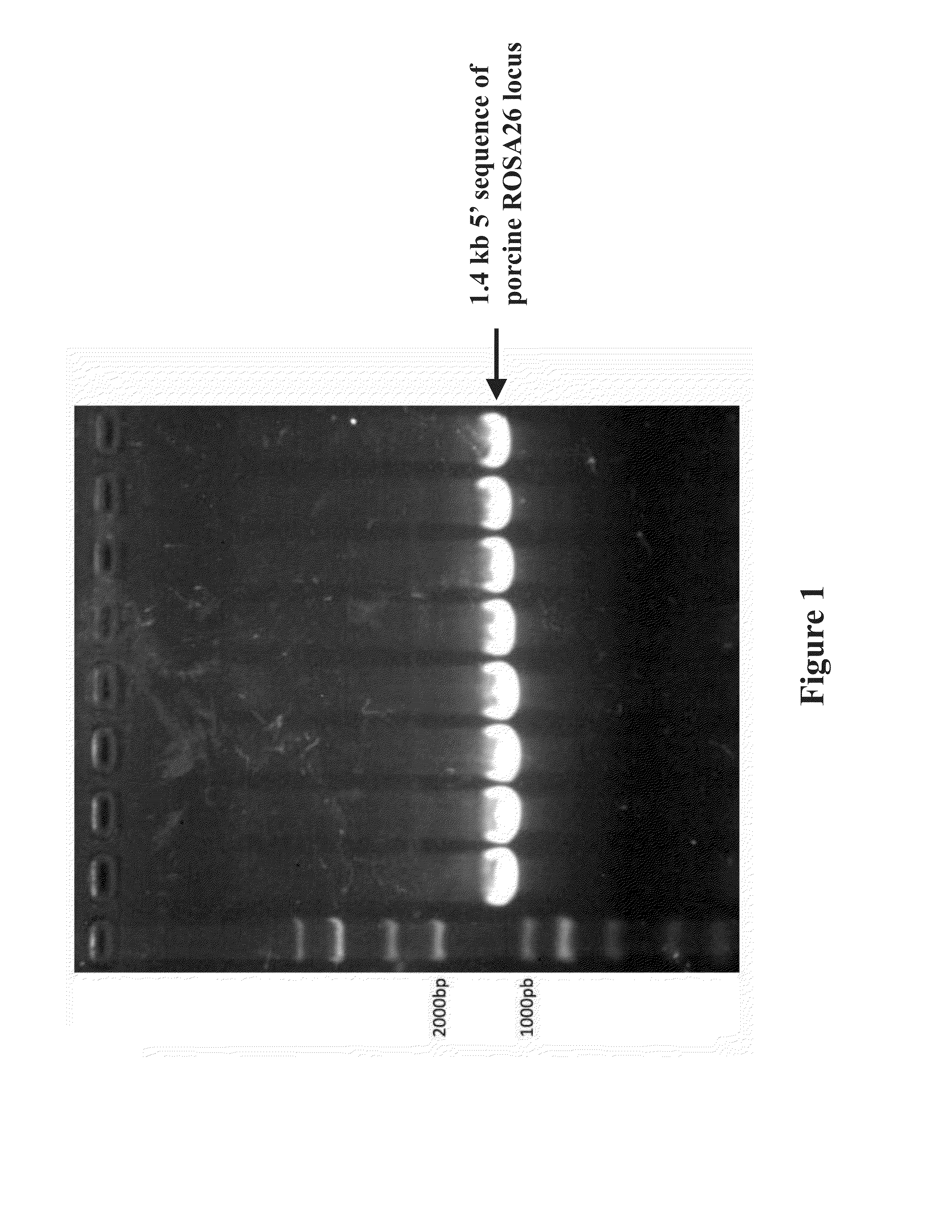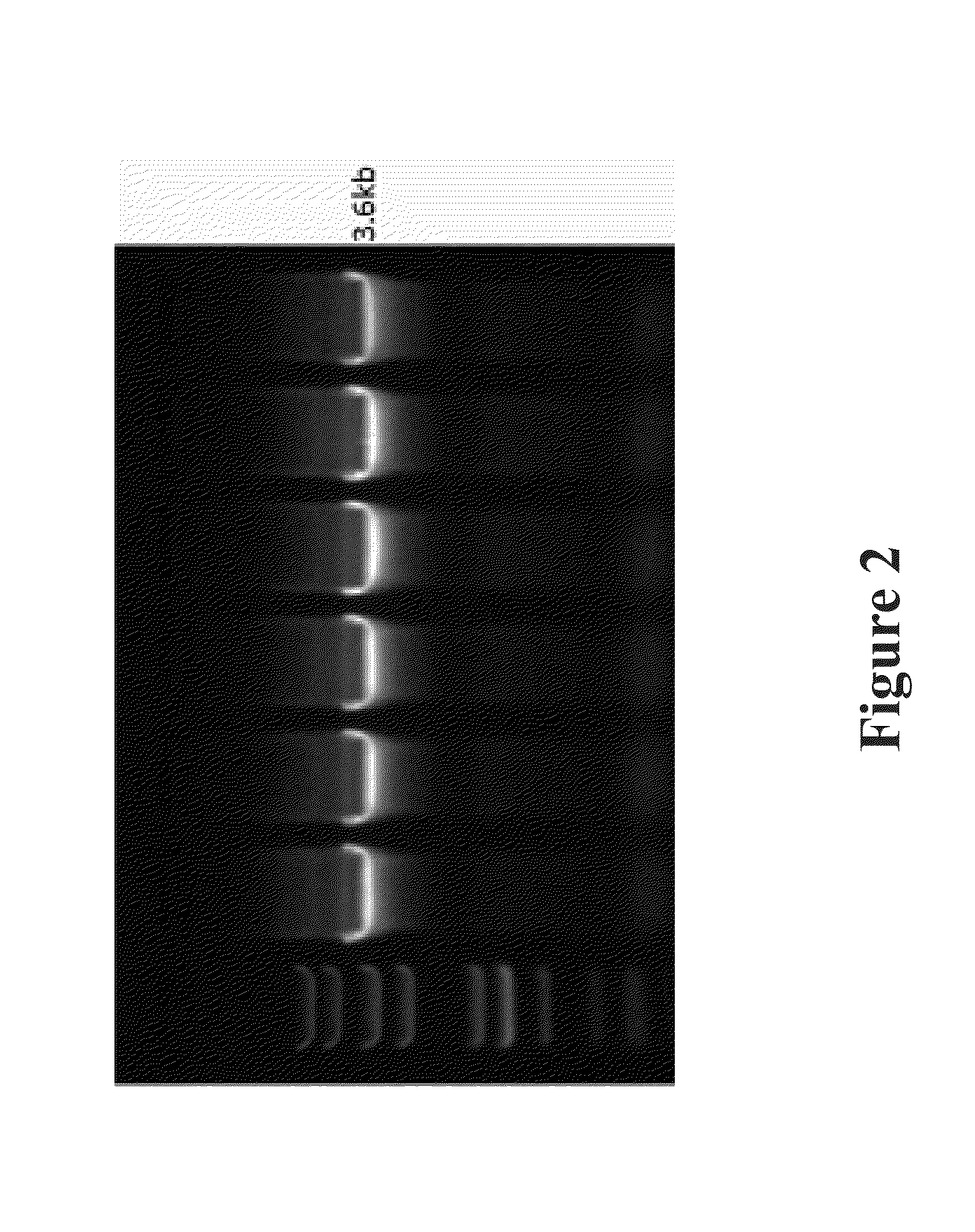Sequence of porcine rosa26 locus and methods of using the same
a technology of rosa26 and locus, applied in the field of gene engineering, can solve the problems of high variability of expression, difficult identification of transgenic animals, and inability to apply rosa26 gene to transgenic livestock
- Summary
- Abstract
- Description
- Claims
- Application Information
AI Technical Summary
Benefits of technology
Problems solved by technology
Method used
Image
Examples
example 1
The Sequence of Porcine ROSA26 Locus
[0030]The sequence of porcine ROSA26 locus is set forth in SEQ ID NO: 1. The porcine ROSA26 sequence can be used in a gene targeting vector (as described below) to specifically target a single copy of exogenous gene to a homologous ROSA26 locus in pig genome and drive stable and ubiquitous expression of the exogenous gene. DNA sequences that can hybridize with porcine ROSA16 gene under stringent hybridization conditions (e.g. hybridization temperature: Tm-10° C. to Tm-15° C.), which can be used to promote expression of target genes, are also included in the scope of the presently claimed invention. Also included are DNA sequences with high sequence identity (>=90%) with the porcine ROSA25 sequence of SEQ ID NO:1.
example 2
Identification of the Porcine ROSA26 Sequence
[0031]The ROSA26 gene was mapped to chromosome 13 in pig genome by a BLAST search of genomic sequences homologous to mouse ROSA26 sequence (Zambrowicz B. et al. Disruption of overlapping transcripts in the ROSA beta geo 26 gene trap strain leads to widespread expression of beta-galactosidase in mouse embryos and hematopoietic cells. Proc Natl Acad Sci USA. 1997, 94(8):3789-94.). Most sequence information was released in NCBI Sscrofa10.2 database. However, there was a gap, about 108 bp, in 3-terminal of porcine ROSA26 gene first intron. Based on sequences flanking the gap, the primers for PCR amplification were designed as: 5′-GGATCTAATTGGAGCTATAACTGCCAGC-3′ (forward) (SEQ ID NO: 3) and 5′-GCTGAGGGTCCCAAATGCTTTG-3′ (reverse) (SEQ ID NO: 4). The PCR amplification was performed as described: 3 min incubation at 94° C. to denature the DNA templates, 30 cycles of 30 seconds at 94° C., 30 seconds at 60° C., 1 minute at 72° C., then 10 minutes a...
example 3
Construction of a Gene Targeting Plasmid Based on the Porcine ROSA26 Sequence
[0032]A gene targeting plasmid based on the porcine ROSA26 sequence was constructed as shown in FIG. 3. The sequence of the gene targeting plasmid was set forth as SEQ ID NO: 2. To construct a gene targeting plasmid, a 1.4 kb 5′-terminal short arm and a 3.6 kb 3′-terminal long arm were amplified, sequenced and subcloned into PPNT6 plasmid at 5′ NotI / 3′ KpnI and 5′ XhoI / 3′ NheI restriction sites, respectively. The primer sequences for amplifying 5′-terminal arm and 3′-terminal arm were listed as follows:[0033]5′-CGGGAGTGCGGCCCGCCCTGCGGC-3′ (5-terminal arm, forward) (SEQ ID NO:5)[0034]5′-AGTAGATCCGTGCTTTTTAACCTATC-3′ (5-terminal arm, reverse) (SEQ ID NO: 6)[0035]5′ -GAGTTTTACAGTCATCCCATTTGTAGACTTTTGC-3′ (3-terminal arm, forward) (SEQ ID NO: 7)[0036]5′-AGCTCTGATCCCGTGT TGTTGTGGCATAG-3′ (3-terminal arm, reverse) (SEQ ID NO:8)
Also, the sequence of IRES-GFP from TRE plasmid (Addgene) was subcloned into PPNT6 plas...
PUM
| Property | Measurement | Unit |
|---|---|---|
| Fraction | aaaaa | aaaaa |
| Digital information | aaaaa | aaaaa |
| Digital information | aaaaa | aaaaa |
Abstract
Description
Claims
Application Information
 Login to View More
Login to View More - Generate Ideas
- Intellectual Property
- Life Sciences
- Materials
- Tech Scout
- Unparalleled Data Quality
- Higher Quality Content
- 60% Fewer Hallucinations
Browse by: Latest US Patents, China's latest patents, Technical Efficacy Thesaurus, Application Domain, Technology Topic, Popular Technical Reports.
© 2025 PatSnap. All rights reserved.Legal|Privacy policy|Modern Slavery Act Transparency Statement|Sitemap|About US| Contact US: help@patsnap.com



